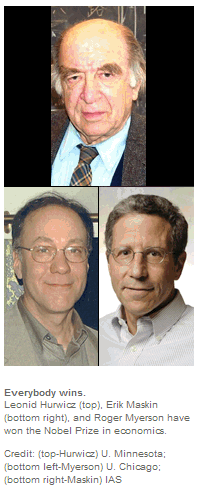|
News & Views item - October 2007 |
Nobel Prize for Economics Given for the Development of Mechanism Design
Theory. (October 16, 2007)
Yesterday's announcement by the Royal Swedish Academy of Sciences reads:
 The Royal Swedish Academy of Sciences has decided to award The
Sveriges Riksbank Prize in Economic Sciences in Memory of Alfred Nobel
2007 jointly to Leonid Hurwicz,University of Minnesota, MN, USA, Eric S.
Maskin, Institute for Advanced Study, Princeton, NJ, USA and Roger B.
Myerson, University of Chicago, IL, USA "for having laid the foundations
of mechanism design theory".
The Royal Swedish Academy of Sciences has decided to award The
Sveriges Riksbank Prize in Economic Sciences in Memory of Alfred Nobel
2007 jointly to Leonid Hurwicz,University of Minnesota, MN, USA, Eric S.
Maskin, Institute for Advanced Study, Princeton, NJ, USA and Roger B.
Myerson, University of Chicago, IL, USA "for having laid the foundations
of mechanism design theory".
The announcement goes on to explain:
The design of economic institutions
Adam Smith's classical metaphor of the invisible hand refers to how the market, under ideal conditions, ensures an efficient allocation of scarce resources. But in practice conditions are usually not ideal; for example, competition is not completely free, consumers are not perfectly informed and privately desirable production and consumption may generate social costs and benefits. Furthermore, many transactions do not take place in open markets but within firms, in bargaining between individuals or interest groups and under a host of other institutional arrangements. How well do different such institutions, or allocation mechanisms, perform? What is the optimal mechanism to reach a certain goal, such as social welfare or private profit? Is government regulation called for, and if so, how is it best designed?
These questions are difficult, particularly since information about individual preferences and available production technologies is usually dispersed among many actors who may use their private information to further their own interests. Mechanism design theory, initiated by Leonid Hurwicz and further developed by Eric Maskin and Roger Myerson, has greatly enhanced our understanding of the properties of optimal allocation mechanisms in such situations, accounting for individuals' incentives and private information. The theory allows us to distinguish situations in which markets work well from those in which they do not. It has helped economists identify efficient trading mechanisms, regulation schemes and voting procedures. Today, mechanism design theory plays a central role in many areas of economics and parts of political science.
Professor Hurwicz, now 90 and the oldest person to be awarded a Nobel Prize, after being told of the award said: "I was surprised. At first, I thought it was some kind of a joke."
Professors Maskin (57) and Myerson (55) as Adrian Cho explains in ScienceNOW: "expanded on Hurwicz's work. For example, in 1977, Maskin developed a criterion for determining just when it's possible to find a set of rules that will guide self-interested participants to the desired end. 'This sets some boundaries on what mechanism design theory can do,' says Massimo Morelli, an economist at Columbia [University]. Starting in the late 1970s, Myerson showed that whenever a mechanism exists, it is also possible to find one that gives participants an incentive to tell the truth."
|
Information for the Public |
|
Scientific Background |